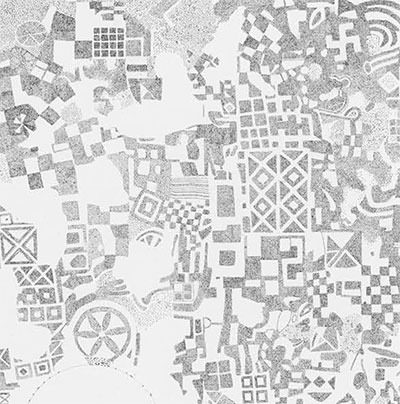 Few excavators are inclined to utter cries of joy when they happen upon a mosaic floor. Mosaics cannot in good conscience be simply ripped up to get them out of the way, and in the way they usually are, especially at sites with any depth of stratification. If they are left in place, deeper digging is impeded and, in addition, measures must be taken for their preservation -usually by covering them again with a thick layer of earth– so that the excavator in the end has nothing to show for his self-restraint. Lifting them is likely to be expensive, the work of trained experts who are seldom available nearby. And since in the Aegean area mosaics are thought to have been made first only in the fifth century before Christ, diggers who are interested in earlier periods are apt to be bored when they appear.
Few excavators are inclined to utter cries of joy when they happen upon a mosaic floor. Mosaics cannot in good conscience be simply ripped up to get them out of the way, and in the way they usually are, especially at sites with any depth of stratification. If they are left in place, deeper digging is impeded and, in addition, measures must be taken for their preservation -usually by covering them again with a thick layer of earth– so that the excavator in the end has nothing to show for his self-restraint. Lifting them is likely to be expensive, the work of trained experts who are seldom available nearby. And since in the Aegean area mosaics are thought to have been made first only in the fifth century before Christ, diggers who are interested in earlier periods are apt to be bored when they appear.
The earliest pebble mosaics in Greece, from Corinth, Olynthus, and Olympia are dated to the later fifth and the early fourth centuries. They are made of natural pebbles of different colors (often merely black and white) laid in patterns on a bed of plaster or cement which binds the pebbles together and holds them in place. A pebble floor at Delphi in the sanctuary of Athena Pronaia, dated in the sixth century, was made with pebbles of different colors laid in a scatter without design–a pebble floor graced by contrasting colors certainly, but without a pattern and therefore hardly to be classed as a mosaic. In the early specimens of proper pebble mosaic all sorts of geometric and floral designs were used–wave pattern, meander, wreaths and tendrils, cable pattern and so on, usually as borders. Where figures occur, they are in simple silhouette with interior divisions indicated by lines of pebbles in contrasting color.
As the art of mosaic-making developed pebbles of different sizes were used, the small ones, densely set, giving the possibility of showing greater detail, shading, and the like. At one phase in the development thin strips of lead were used to outline figures and to set off details. It has been surmised that for the conventionalized border designs, which repeat themselves over a wide area with little variation, pattern books were used. For human and animal figures it is likely that cartoons or drawings to be copied were prepared in advance, just as cartoons were used for fresco painting in Italy of the Renaissance. Like fresco painting which has to be done while the plaster on the wall is still wet, mosaic-making must be done quickly before the binding material or cement sets hard. Without a cartoon or a previously prepared drawing, figures set freehand or by eye are likely to come out with queer anomalies in their proportions (as, indeed, some early mosaic figures did). In theory, then, one might suppose that mosaic-making should belong to a literate age when conveniently portable writing and drawing materials were available for the making of pattern books and the drawing of cartoons.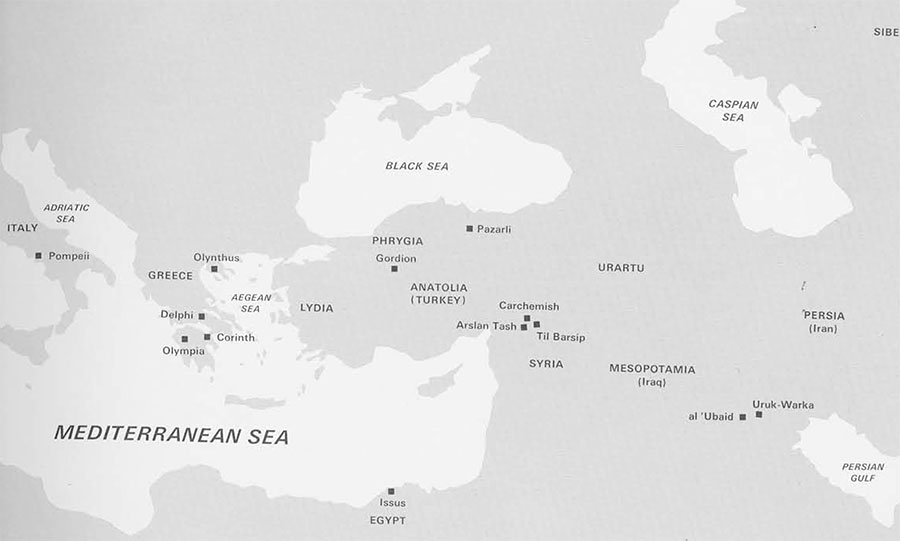
The art of making mosaic floors with natural pebbles was the precursor of true mosaic, in which colored stones, terracotta, and eventually glass, were broken or cut to make artificial teserae of various shapes and sizes which could be fitted together to make more detailed and more sophisticated pictures. True mosaic early displaced the more primitive form, and in late Hellenistic and Roman times produced many masterpieces which have been the subjects for detailed studies by art historians. Some of these prove in a way our hypothesis that cartoons must have been used, for they are copies or adaptations of pictures famous in antiquity, of which the originals, on perishable material, have vanished. The best known of these, perhaps, is the large mosaic from the House of the Faun at Pompeii, which shows Alexander and Darius at the Battle of Issus.
By contrast, the study of pebble mosaics and the origins of mosaic-making has been curiously neglected. For this reason there was at hand no convenient list of stylistically analyzed and dated mosaic floors to refer to when the first specimen appeared at Gordion in 1951. With some training in Greek archaeology and with a preconception (shared by many) that certainly by the fifth century innovations appearing in central Anatolia must have come from Greece (or from Persia), we tried to fit the first Gordion mosaic into a Greek framework. Since, as has already been noted, the earliest Greek pebble mosaics are dated to the second half of the fifth century, and since an interval must be allowed for the transmittal of this new medium from the coast to the hinterland, a date in the early fourth century seemed indicated on historical and on logical grounds. Yet even at that time we felt uneasy about such a dating, for on purely archaeological grounds it seemed late.
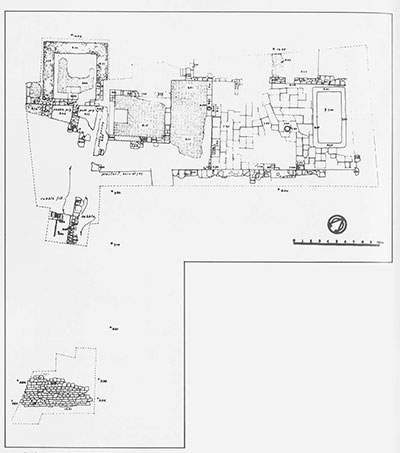

The mosaic, cleared in its entirety in 1952, proved to occupy the inner room and the colonnaded porch of a building described in The University Museum Bulletin for December 1953 (Vol. 17, No. 4). This building overlay the two southernmost rooms of a large structure belonging to the archaic settlement at Gordion (Building A on the plan), which had been destroyed, perhaps by an earthquake, just after the middle of the fifth century. Its successor, though smaller, was embellished by a colonnaded facade, decorated with revetment tiles of moulded terracotta gaily painted, and paved with pebble mosaic floors: evidently a building far above the average in elegance and probably one that served a public or official function. An oblong area at the back of a large inner room, not covered by the mosaic, had once been occupied by something else–an altar, perhaps, or a cult statue, or conceivably a throne or a judgment seat. The finding in the area of the building of a carnelian cylinder seal of Achaemenian style and bearing an Aramaic inscription suggested that here may have been the residence of the local representative of the Great King in the late fifth century; and if this had been the case there should have been no great lapse in time between its construction and the destruction of its predecessor. We would have liked to date its building in the third quarter of the fifth century, between 450 and 425, but because of the presence of the mosaic floors we suggested a dating in the late fifth century or early in the fourth.
In any case, the porch and the inner room were both sumptuously paved with floors of pebble mosaic, pale blue and white natural pebbles laid in a design of strips occupied by repeating squared volutes growing to either side from a central stem–a simple but effective geometric pattern. The pebbles, oval or almond-shaped were closely laid on end, their rounded tops forming the surface of the floor. For the most part they measured two to three centimeters in length (an inch to an inch and a half) so that the work was reasonably fine. The lower ends must have been embedded in some binding material; but over the centuries this had lost its cohesiveness and become a powdery grey substance. Probably the binder used was an organic material: certainly not lime. Beneath, there seems to have been a bedding layer of coarser pebbles or of crushed stone. The design, though simple, was competently executed and the result effective.
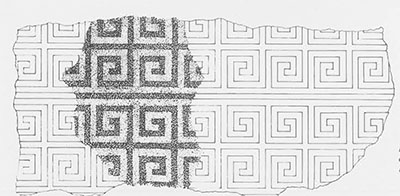
Later on in the course of the excavation another pebble mosaic floor appeared at the west side of the great trench. This proved to lie in the anteroom or pronaos of another of the buildings (H on the plan) of the archaic city. In this case, however, the floor belonged to the archaic building itself and not to a later rebuilding above it. The pebble floor had been laid directly on the surface of the deep layer of clay which had been piled over the ruins of the old Phrygian city to form a bed for the new archaic settlement. The foundations of Building H went deep into the clay layer and had evidently been put in at the time when the clay was laid down. In style and technique the floor was like the one already described: simple geometric patterns, this time in brown and white pebbles laid on end mostly in a checkerboard design. A long period of use was attested by an irregular patch or repair in pale blue and white pebbles laid without a pattern. The building adorned by this floor must date from sometime in the sixth century, and presumably the mosaic itself was contemporary. Elsewhere in the archaic city bits and scraps of mosaic floors, none of them well enough preserved to show any complete designs, suggest that this settlement even in its original phase was liberally decorated with pebble mosaics and that the technique of making them was well known before the middle of the sixth century. This would intimate that the first mosaic found in 1951 was not necessarily influenced by Greek mosaics in the same technique, but rather that there was a continuing local tradition for making simple mosaic floors of natural colored pebbles, which ran back at least as early as the middle of the sixth century. In estimating a date for our first mosaic we should have stuck by the archaeological evidence and by our own intuitions rather than tried to fir it to a frame of reference which proved in the end irrelevant We begin to feel, in fact, that the flow of influence was not from the coast to the hinterland but rather the reverse, especially since the only Greek pebble floor dated as early as the sixth century was found at Delphi, an oracular center often consulted and in return suitable endowed with rich offerings (and perhaps with other things less material, ideas and innovations) by Croesus and Gyges of Lydia, still earlier by Midas of Phrygia.
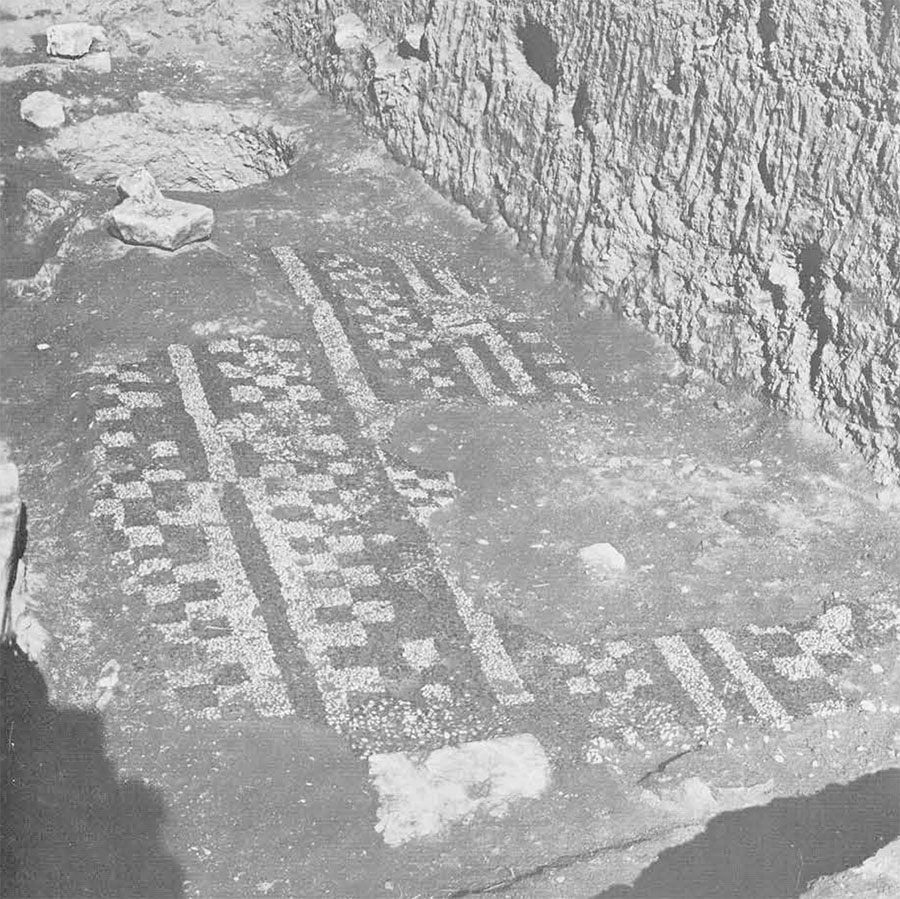
Deeper excavation at Gordion, of course, brought to light pebble mosaics of still earlier date, demonstrating that the art of mosaic-making was well known there as early as the eighth century. Since no Greek mosaics as early as these have been found, the Aegean area and the west would seem to be eliminated as a source for the art in Phrygia. If anything, the earlier Greek mosaics may have been influenced by the still earlier Phrygian ones: certainly not the reverse. The direction of the flow of influence turns out to be precisely the opposite of what had been expected, and the sixth and fifth century mosaics at Gordion become late specimens in a continuing local technique and tradition, developed without influence from the west.
Before looking for a source for the Phrygian pebble mosaics in the opposite direction, in the east, however, let us look briefly at the eighth century specimens found at Gordion itself. Three of the buildings of the Phrygian city had been decorated with pebble mosaic floors. Two of these had been destroyed in the holocaust at the beginning of the seventh century; the third, on the opposite side of a broad open square, had not been burned but had been abandoned and razed at the same time or immediately thereafter. All three, then, had been built and their mosaic floors had been laid, at some time in the eighth century.
The latest of the three buildings, cleared in 1963, lay at the northeast corner of a large open square. It had not been burned; evidently on the day of the fire the wind was blowing form the north, or the flames were unable to leap the broad paved space of the square. The paving of fitted stone slabs had been laid at the time of a program of urban renewal when the earlier square, surfaced by a cobbled floor which sloped rather sharply from south to north had been filled with earth along the lower north side and levelled to an even surface to carry the paving. The building at the northeast corner belonged to this period and lay at the level of the stone paving, evidently bedded on a filling about a meter deep which had been thrown in when the square was levelled. The building itself was preserved only in its foundations; all useful building material from above floor level had been carried off for reuse elsewhere. At the same time, the pebble floor was ripped up, so that only narrow strips along the wall faces remained in place. These show pebbles of various colors evidently arranged in groups and masses by color–not in a scatter–, so that although no patterns could be identified it was evident that patterns there had been.
The second mosaic lay in a building at the southeast corner of the square, opposite the first. In plan, the building was of the megaron type with inner and outer room, a round hearth at the center of each. The structure was of crude brick reinforced by a timber framework and this, with the roof of wooden beams covered by reeds and clay had burned fiercely and in its collapse destroyed for the most part the mosaic floor which lay in the outer room. Enough was preserved in bits and pieces, however, to show that it had been a true pebble mosaic made with natural pebbles of red, yellow, blue, and white laid to form various geometric patterns.
The floor of the larger building next door at the west was better preserved despite the fact that this building too had been destroyed in the fire. Here the mosaic covered not only the shallow vestibule but the larger inner room as well. The dimensions of the inner hall were about ten by eleven meters (32 by 35 feet). The mosaic floor, well enough preserved in crucial places and not broken by holes for posts, shows that there were no interior supports for the roof. At one inner corner, an oblong area not covered by mosaic must have been occupied by some interior installation which has left us no hint as to its character.
The pebbles of this extensive floor were laid in the manner familiar to us from the later mosaics at Gordion. Again they were small and oval or almond-shaped, their maximum length only two to three centimeters (one to one and a half inches). The binding material, whatever it had been, had lost its cohesiveness and many of the pebbles were loose, which made the cleaning of the floor difficult in the extreme. Dark red, dark blue, and white pebbles were used, with an occasional yellow one and grey where patches or repairs had been made later. The design (if it may be so called) of the mosaic was a scatter of geometric patterns with no overall plan and no relation either to the oblong room it filled or to the round central hearth within it. Obviously a floor so lacking in design had been laid without a plan and without the help of previously prepared drawings which might have related the pattern of the mosaic to the space it occupied. Clearly we are in an early phase of mosaic-making as a decorative enhancement for architecture. A glance at the drawing of the whole floor will show that the separate units or patterns follow in a general way the main axes of the room, but almost always with a slight deviation; and that simple geometric designs which one might expect to be symmetrical are in almost every case lopsided or otherwise out of proportion. A good example is the swastika near the upper right corner; its arms are of unequal length, are not precisely parallel to each other, and do not cross cleanly at the center. Such asymmetries and anomalies are clear indications that this mosaic floor was laid free-hand and by eye; the resulting disproportions are not so important in these simple geometric patterns as they would be in human or animal figures.

The repertory of geometric motives–swastikas and crenellations, checkerboard and lozenges, hollow squares, triangles and hourglasses– can be matched at Gordion on the engraved bronze work, the inlaid wooden furniture, and the painted pottery of the same period. The large rosette above the hearth may have been laid out as a circle by use of the compass, as was done for similar rosettes engraved on bronzes, where the central prick around which the compass was rotated is often plainly visible, but in the mosaic the six petals within the circle were clearly set freehand. Various other motives curvilinear rather than purely geometric were used, notably the concentric half circles beside the swastika at the upper right corner. Some of these were used merely as space-fillers; others, fairly elaborate, seem to form no specific pattern and to make no sense; while still others exercise the imagination. Near the right side of the floor and at the level of the center of the hearth a large double-humped dark mass on a light ground might be interpreted as an animal: the lozenge or diamond of white in its left side seems to separate the forelegs of an animal abobe from the hind legs below, and the two humps above might be head and rump; but it is difficult to imagine what part of an animal can be represented by the shapeless blob in front of (actually above) it–perhaps its prey which it is eating. In one place a small animal representation is certain: just below the hearth at the left, beside a dark panel containing a small white swastika, lies another dark panel with an animal outlined in white (standing on its nose), the head downward and the legs toward the left. The proportions of the animal are reasonably normal for an outline laid freehand.
It may be observed that in a number of places, and particularly at the top, the mosaic has been patched or repaired in irregularly-shaped areas with plain grey or white pebbles. These patches suggest that the floor had a fairly long period of use and suffered considerable wear. The stratification outside shows that the building itself went through three or more successive phases during its period of use; it had a long life. Since it was destroyed at the beginning of the seventh century, a guess at a time of construction around the middle of the eighth or even earlier, would it seems, be conservative; and so we may suggest a date around 750 for the laying of the mosaic floor. In the summer of 1963, the best preserved parts of the floor were taken up and mounted on cement slabs by Muzaffer Ertoren, the expert from the Turkish Department of Antiquities. This gave an opportunity for a little digging beneath its level and a small hole was made which showed an earlier floor, of hard earth with occasional pebbles in its surface, at about twenty centimeters below. Since the walls of the building continue down to the level of this earlier floor and somewhat below it, this must have been the original floor of the house; the raising of the level and the laying of the mosaic inside the house may have been connected with the leveling and repaving of the square outside at the north. We are not yet in a position to establish such a connection, or to date the improvement.
In any case we have at Gordion three pebble mosaic floors which were laid well before 700 B.C. What was their origin or the source of their inspiration? That it could hardly have been in the west has already been noted. Since Gordion lay on a busy east-west trade route across Anatolia, the source might well lie in the east wehere art and culture were more anciently established and more continuously developed than in the west. At Gordion, tutelage from the east had already been hinted by the findings in the Hellenistic and archaic levels of terracotta pegs, some of which had had their heads dipped in glaze to give color contrast and variety. Pegs and cones of terracotta such as these were made from earliest times in Mesopotamia, where they have been found at al-Ubaid and Uruk-Warka. Although no mosaic of terracotta pegs had been found at Gordion the finding of individual pegs which must have been the components of such a mosaic is suggestive; and a fragment of such a peg mosaic has actually been found in Anatolia at Pazarli, dated with probability to late Phrygian times in the sixth century. The models for such peg mosaics must have been Mesopotamian; but in Anatolia this artificial technique for making mosaic must necessarily have been always an import and an exotic. The flat alluvial plains of Mesopotamia are lacking in natural pebbles for the making of mosaic, and so the component tesserae had to be made artificially. In lands like Anatolia where varicolored natural pebbles were easily to be found, the substitution of pebbles for terracotta cones and pegs was natural and allowed the development of a new technique.
The substitution was made in the east in North Syria, as well as in Phrygia. At Arslan Tash and at Til Barsip to the east of the Euphrates River in the neighborhood of Carchemish, pebble floors have been found in palaces attributed to the time of Tiglathpilesar III (745-727 B.C.). At Arslan Tash the great court of the palace, open to the sky, was floored by a mosaic of black and white pebbles laid in a checkerboard pattern. The pebbles are described as five to eight centimeters in length (two to three inches). At Til Barsip black and white pebbles of comparable size were used for a mosaic slightly more sophisticated in design: in each black square of the otherwise identical checkerboard pattern there was a ring of white pebbles, and in each white square a ring of black. This mosaic lay in a long corridor, again evidently open to the sky since it is sloped rather sharply from one end to the other for drainage.
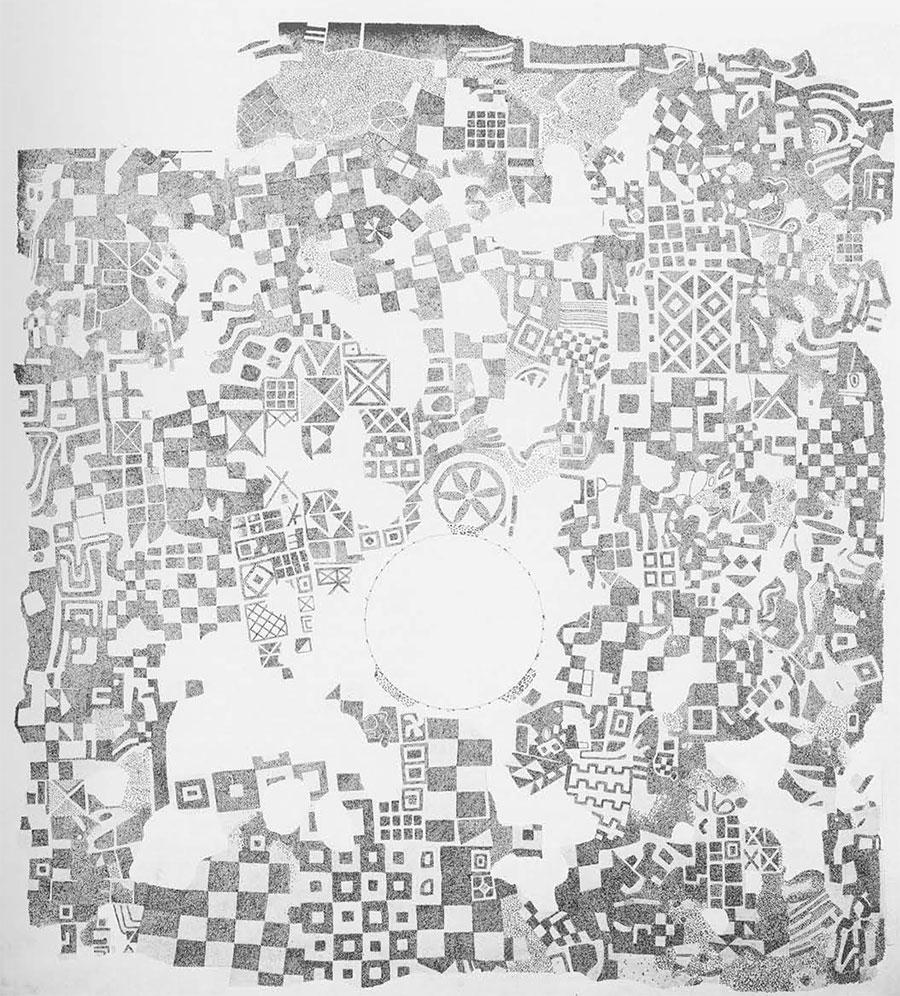
A comparison of the North Syrian mosaics with the roughly contemporary Phrygian ones at Gordion shows the former to be outdoor paving rather than indoor embellishment; they are coarse–practically cobblestones by comparison; they are simple in color since they use only black and white; and they are elementary in design which is limited to checkerboard and elaborations on it. If the Gordion mosaics were made at approximately the same time as the North Syrian, as seems likely, then the flow of influence (if any) would seem to have been from west to east since the Phrygian mosaics are infinitely more advanced in their technique and sophisticated in their colors and patterns. The cities of North Syria may be eliminated as a source of inspiration for the art of mosaic-making in Phrygia–or eliminated at least until better specimens of indoor mosaics of multi-colored pebbles laid in intricate patterns may be found there.
For the pebble floors of Gordion, then, there would seem to be no earlier models known at present, either in the west or in the east. Can they have been an invention made locally Although a study of Phrygian art as we know it suggests a number of influences from other parts of the eastern world–from Assyria and North Syria, from Urartu and even from Iran–the amalgam has always a Phrygian flavor of its own. The Phrygians had their proper geometric tradition, as well as enough imagination and creativity to adapt ideas from outside to their own needs and taste, and to put their own stamp on them. Nor were they receivers only of other peoples’ ideas and products. Their fibulae appear at many places outside Phrygia, some of their bronze vessels were not only exported but imitated in lands outside. They were certainly capable of inventing pebble mosaics; and if we look at a colored picture of the eighth century floor at Gordion we may perhaps recognize its inspiration. The general effect is that of a rich oriental rug or carpet, giving a strong impression of color with little emphasis on overall design. Most of the simple geometric motives moreover are of a sort easily and endlessly produced in the weaving of textiles; witness the patterns of many a rug produced on village looms all over the world and at almost any period of history. Ancient Phrygia was famed for its textiles and embroideries, and many scraps of these were found not only in the Gordion tombs but also in the burned eighth century city. The scraps of textile from the largest megaron ( M 3) have been published by Louisa Bellinger in the Bulletin of the Needle and Bobbin Club of New York (Vol. 46 Nos. 1-2). Intricate weaving and geometric patterns in contrasting colors can be recognized on many of these, and Miss Bellinger gives in drawings the restored patterns of some. There was a plentiful supply of wool on the Anatolian plateau for weaving and felting, and it is therefore not in the least unlikely that the Phrygians wove carpets and rugs with geometric patterns in bright colors to cover the floors of their houses.
That large rugs of this sort existed in ancient times is attested by the specimen from Pazaryk, miraculously preserved to our time together with the other contents of a tombin the Altai region of southern Siberia, dated to about 450 b.C. The carpet is of knotted wool pile and measures about six by six and a half feet; it is probably Persian in origin. The tomb had become filled with water and frozen, and to this deep freeze, which lasted for 2,400 years until its discovery and excavation in 1949 by the Russian archaeologist Rudenko, we owe the preservation of unique perishables of leather, wood, and textile. Phrygian rugs at Gordion, somewhat earlier than the Pazaryk carpet, would have been in the style of their own time, geometric; and to someone in Gordion it may have occurred to reproduce them in more durable and more permanent form, in pebble mosaic.
Thus occur pebble floors at Gordion which at first seemed so boring, have led us back through the centuries to examples earlier than any that were previously known. They have no parallels elsewhere, and they suggest that the art of mosaic-making was invented and first practiced in Phrygia in the eighth century. And so, if the inspiration for pebble mosaics truly lay in gaily colored woven carpets, we have at Gordion not only the first pebble mosaic floors, but also the first attempt at permanent mothproofing!
